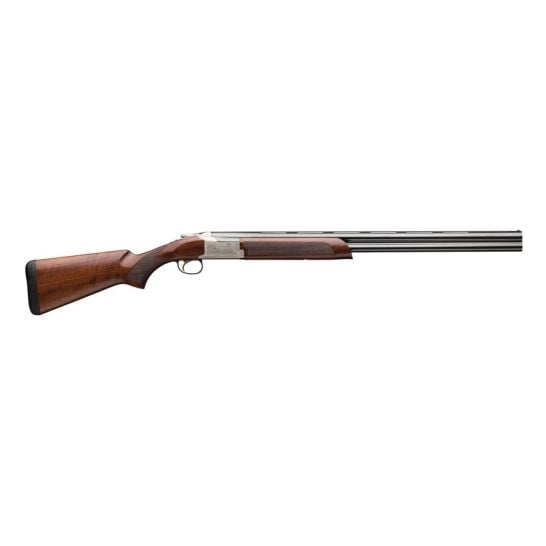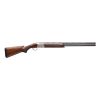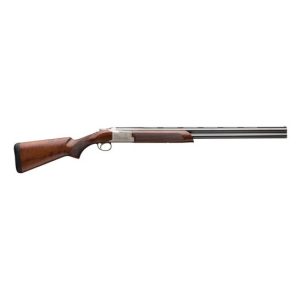Browning Citori 725 Field 28 Gauge Break Action Shotgun – Black Walnut, 28" Barrel, Precision Craftsmanship for Sporting and Hunting – 018165013 For Sale
$2,579.99
The Browning Citori 725 Field 28 Gauge Break Action Shotgun is a precision-crafted firearm designed for both sport and hunting enthusiasts. Building on the reputation of the original Citori Field, it introduces a modern low-profile receiver design for enhanced performance while maintaining Browning’s trademark durability. Key features include a robust full-width hinge pin, tapered locking bolt, FireLite Mechanical Trigger for lighter and more precise trigger pulls, and an Inflex technology recoil pad for improved comfort during prolonged use. This shotgun represents a blend of tradition and innovation, offering serious shooters refined performance and the lasting quality associated with the Browning brand. Whether in the field or on the range, the Citori 725 provides an exceptional shooting experience.
What is the difference between Citori and Citori 725?
The main differences between the Browning Citori and the Citori 725 shotguns lie in their design, weight, and features:
1. **Design and Ergonomics**:
– The Citori 725 features a lower-profile action compared to the traditional Citori. This gives the 725 a sleeker profile and offers improved handling and balance.
2. **Weight**:
– The Citori 725 is generally lighter than the older Citori models, which can make it easier to handle and more comfortable for a full day of shooting.
3. **Trigger System**:
– The Citori 725 is equipped with the Fire Lite mechanical trigger, which is designed to provide a lighter, more responsive pull compared to the inertia-style triggers in some of the older Citori models.
4. **Recoil Management**:
– The Citori 725 often includes advanced recoil reduction technology, such as the Inflex II Technology recoil pad, designed to redirect and reduce felt recoil, enhancing shooting comfort.
5. **Barrel Dynamics**:
– The Citori 725 typically features Back-Bored barrels, which offer improved shot pattern performance by reducing pellet deformation.
6. **Aesthetics and Customization**:
– Both models offer a range of aesthetics and customization options, but the Citori 725 might offer some newer finishes and stock configurations based on recent updates.
These distinctions make the Citori 725 a more modern iteration designed to improve shooter experience through enhanced ergonomics and performance technologies.
Is the Browning Citori 725 a good gun?
The Browning Citori 725 is generally considered a good shotgun. It’s highly regarded for its quality craftsmanship, reliable performance, and versatility. The Citori 725 features improved engineering over previous models, with a low-profile receiver, mechanical trigger, and back-bored barrels for better patterns. These attributes make it well-suited for both hunting and sporting purposes, such as clay shooting. However, as with any firearm, the suitability of the Browning Citori 725 depends on individual preferences and needs, including budget, fit, and intended use.
Is the Browning Citori worth the money?
The Browning Citori is generally considered worth the money by many enthusiasts and experts due to its quality craftsmanship, durability, and performance. It is a well-regarded over-under shotgun known for its reliability and versatility, suitable for both hunting and sporting activities. Ultimately, whether it is worth the investment depends on personal preferences, intended use, and budget. For those seeking a high-quality shotgun with a solid reputation, the Browning Citori often meets expectations.
What is a used Browning Citori worth?
The value of a used Browning Citori can vary widely based on factors such as its condition, age, model, and any special features or customizations. Generally, a used Browning Citori might be valued anywhere from around $1,000 to $3,000 or more. To get a more accurate estimate, you might consider checking online marketplaces, consulting with local gun shops, or seeking appraisals from firearm experts.
What does Browning Citori mean?
The Browning Citori is a line of over-and-under double-barreled shotguns produced by the Browning Arms Company. It is known for its quality craftsmanship, durability, and performance in hunting and competitive shooting. The Citori is a popular choice among shotgun enthusiasts and is available in various gauges and configurations to suit different shooting preferences and activities.
What is the difference between Browning 725 and 825?
The Browning 725 and 825 are both models of shotguns produced by Browning, a well-known firearms manufacturer. The key differences between the two models primarily involve design, features, and target market, which can vary by region and model year. Here are some general distinctions:
1. **Target Market:**
– The Browning 725 is widely available in markets like the USA and is known for its use in both hunting and competitive shooting.
– The Browning 825 might be more region-specific, such as markets in Europe or Asia, and caters to those specific market preferences.
2. **Design and Features:**
– The 725 usually features an improved mechanical trigger system, lower-profile receiver, and advanced recoil pad, providing enhanced handling and reduced felt recoil.
– The 825, depending on the specific model iteration, may have different design nuances or wood grades and finishes tailored for a specific clientele.
3. **Technical Specifications:**
– While both models share core Browning characteristics, specifics like barrel lengths, wood finish, engraving, or additional accessories could differ, catering to varying tastes and shooting disciplines.
4. **Availability and Configurations:**
– Since the names and specific models can vary with the country, the exact differences can often depend on the iterations available in different regions, reflecting local shooting styles or preferences.
For precise and updated differences, it’s advisable to check the latest specifications from Browning or consult with a local firearms dealer familiar with the models available in your area.
When was the Browning Citori 725 made?
The Browning Citori 725 was introduced in 2012.
Does Browning make a 28 gauge shotgun?
Yes, Browning manufactures 28 gauge shotguns.
Does Browning Citori have ejectors?
Yes, the Browning Citori is equipped with ejectors.
What are the grade levels of Browning Citori?
The Browning Citori is a line of over-under shotguns, and it comes in various grade levels that often denote differences in features, materials, and embellishments. The typical grade levels for Browning Citori models include:
1. **Field Grade** – Basic model for general use.
2. **Grade I** – Standard model with basic features.
3. **Grade II/III** – Enhanced designs and higher quality wood.
4. **Grade VI** – High-grade walnut and engraving.
5. **Grade VII** – Superior wood grade and intricate engravings.
Additionally, there might be special editions and custom grades that feature unique designs or limited-edition releases.
How long will a Browning Citori last?
The lifespan of a Browning Citori, like many high-quality shotguns, can be extensive if properly maintained. With regular cleaning, proper storage, and occasional servicing, a Browning Citori can last for decades, often passing from one generation to the next. It’s not uncommon for these shotguns to last 50 years or more, especially when used and cared for responsibly. Frequent use and exposure to harsh conditions can impact longevity, but still, these guns are built to endure significant use.
What is the difference between Browning Citori grade 1 and 2?
The main differences between the Browning Citori Grade I and Grade II typically lie in their aesthetics and detailing. Here are some of the distinctions:
1. **Wood**: The Grade I usually comes with a plainer, standard-grade walnut stock, whereas the Grade II often features a higher-grade walnut with more attractive grain patterns and possibly additional checkering.
2. **Engraving and Finish**: The receiver of the Grade I typically has basic engraving, while the Grade II might have more elaborate and detailed engraving on the metal parts.
3. **Pricing**: Due to the higher quality of materials and craftsmanship, the Grade II is usually priced higher than the Grade I.
Both grades maintain the same mechanical functions and reliability, ensuring similar performance, but the Grade II is targeted at those who appreciate enhanced aesthetics.
What is the difference between Browning Citori grade 1 and grade 2?
The primary differences between the Browning Citori Grade 1 and Grade 2 shotguns generally relate to the level of detailing and finish.
1. **Engraving and Aesthetics**: The Grade 2 typically features more elaborate engraving compared to the simpler patterns on the Grade 1. The engraving on Grade 2 might cover a larger portion of the receiver and include more intricate designs.
2. **Wood Quality**: Grade 2 usually comes with higher grade wood, offering more attractive grain patterns and potentially a higher gloss finish. The wood used in Grade 2 is often selected for its aesthetic appeal.
3. **Checkering**: The checkering on the wood stock may be more refined or feature different patterns on the Grade 2, providing a better grip and enhanced visual appeal.
Overall, the Grade 2 is considered a step up in terms of visual enhancements and wood quality, but mechanically, both grades generally function the same. It’s speculated for people to review the specific year and model details as variations may occur between production years.
When did the Citori 725 come out?
The Browning Citori 725 was introduced in 2012.
What is the difference between 525 and 725?
The difference between 525 and 725 is 200.
Be the first to review “Browning Citori 725 Field 28 Gauge Break Action Shotgun – Black Walnut, 28" Barrel, Precision Craftsmanship for Sporting and Hunting – 018165013” Cancel reply
Related products
Browning Citori 725 Field 28 Gauge



Reviews
There are no reviews yet.